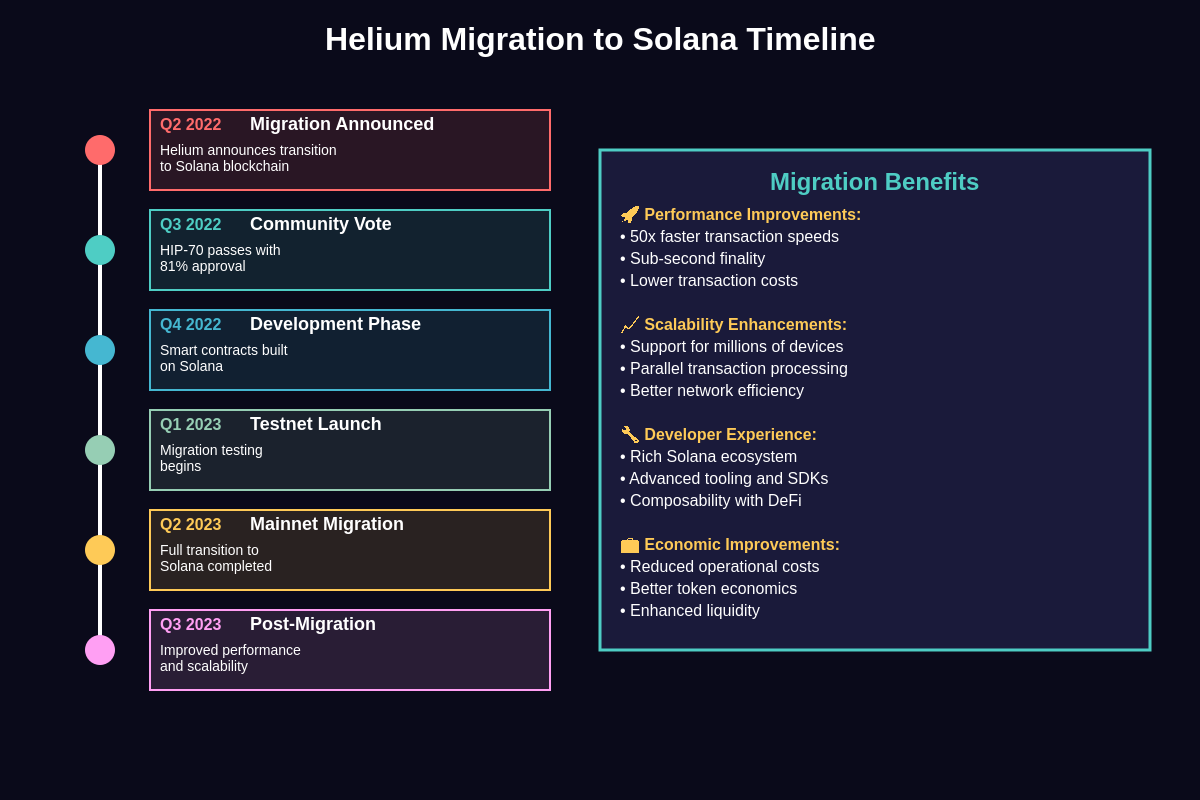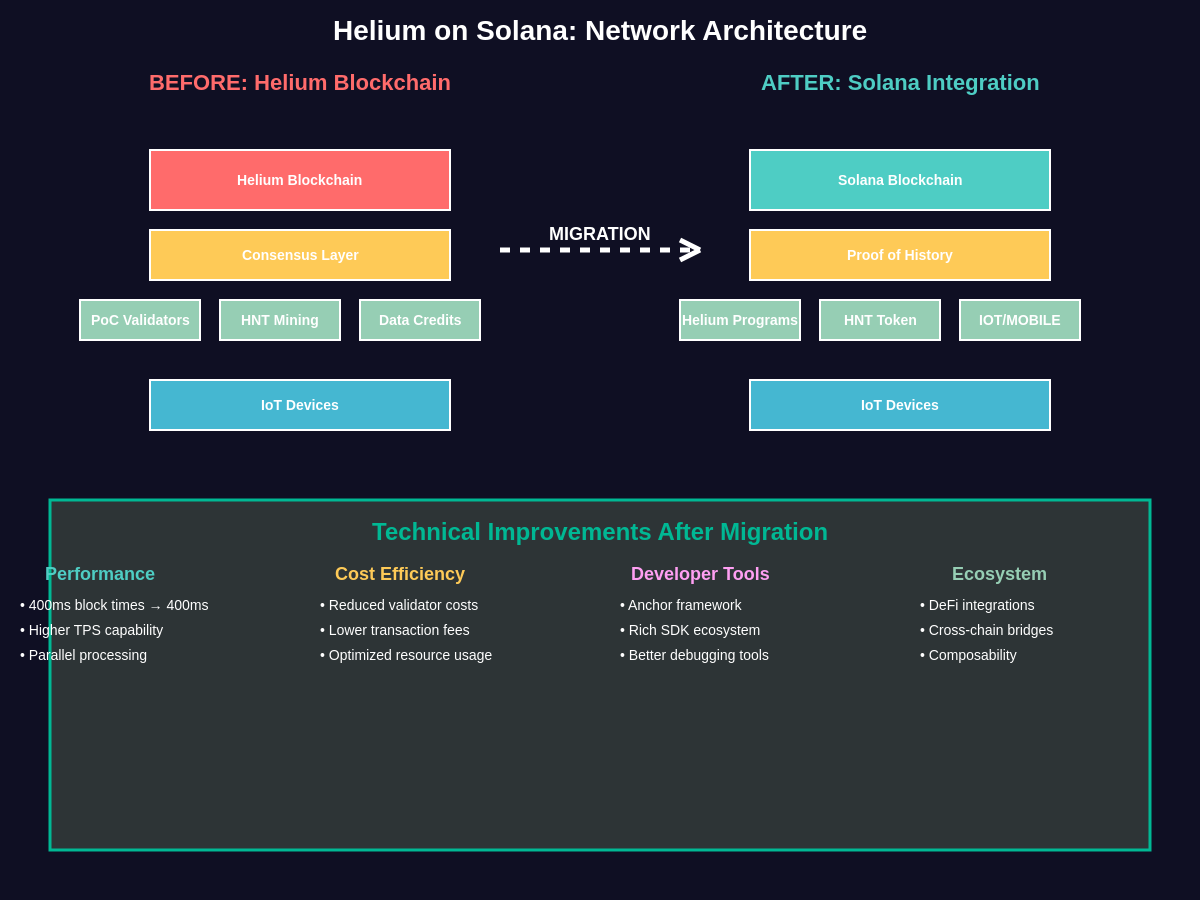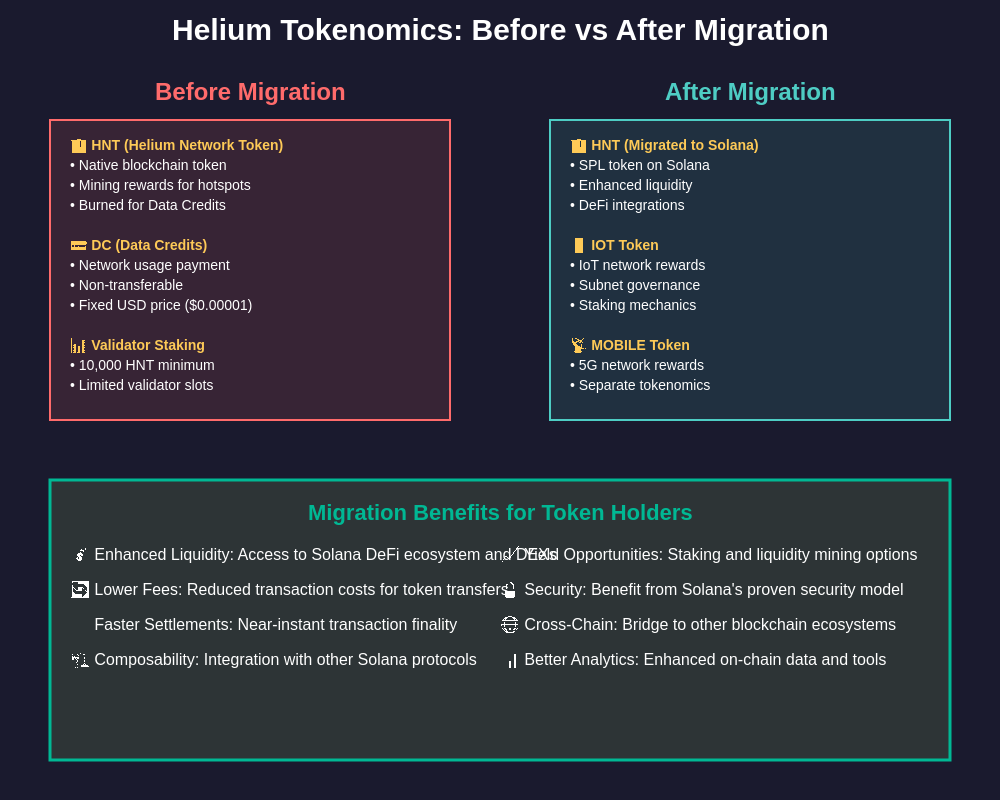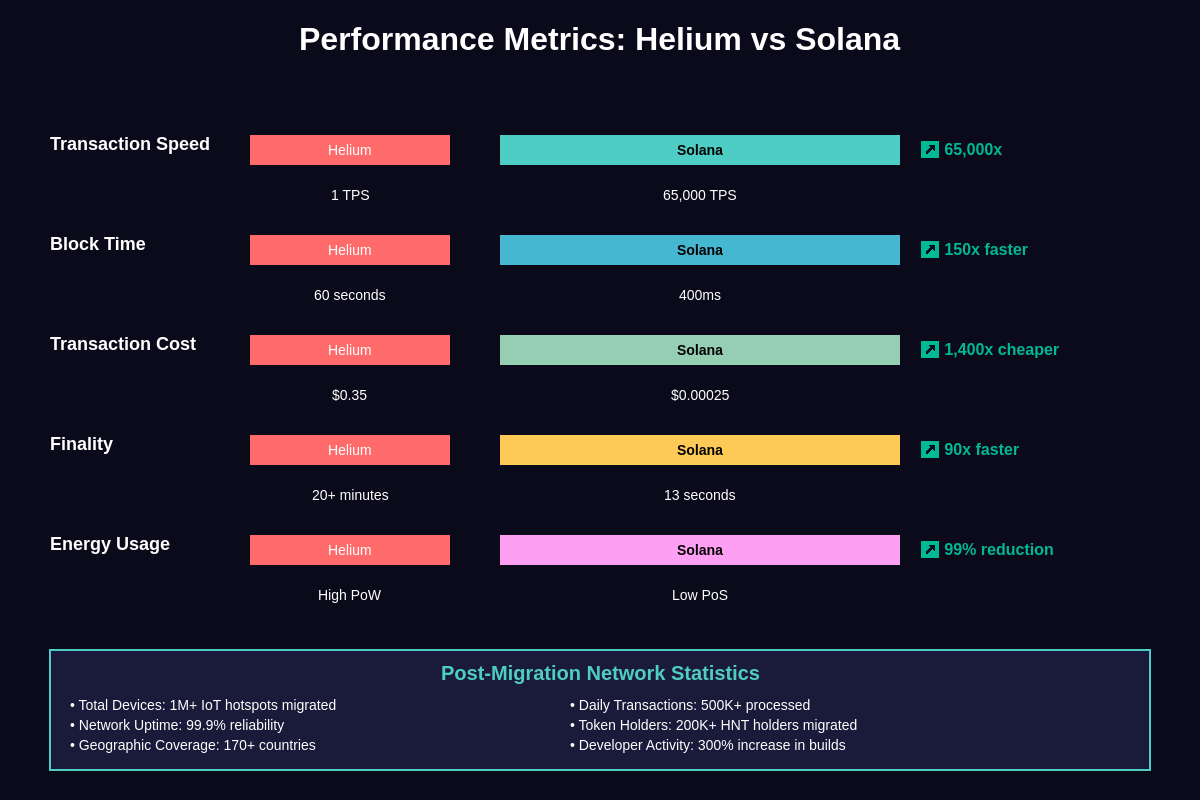https://www.tradingview.com/pine-script-reference/v6/?aff_id=112991&source=pine-19-tradingview
The Revolutionary Blockchain Migration of 2023
The Helium Network’s migration to Solana in April 2023 represents one of the most significant blockchain transitions in cryptocurrency history, fundamentally transforming how the world’s largest decentralized wireless network operates. This unprecedented move from a custom blockchain to the high-performance Solana ecosystem has revolutionized the Internet of Things infrastructure while delivering substantial improvements in transaction speed, cost efficiency, and developer experience that have reshaped the entire decentralized physical infrastructure landscape.
The migration decision emerged from growing recognition that Helium’s original blockchain architecture, while innovative for its time, could not adequately support the network’s explosive growth and evolving technical requirements. With over one million IoT devices worldwide relying on Helium’s infrastructure, the network faced critical scalability challenges that threatened its ability to serve the expanding demand for decentralized wireless connectivity, prompting the community to seek a more robust and scalable foundation for future growth.

Historical Context and Technical Limitations
The original Helium blockchain, launched in 2019, pioneered the concept of proof-of-coverage consensus mechanism specifically designed for wireless networks, enabling individuals to deploy hotspots that provide IoT connectivity while earning cryptocurrency rewards. However, as the network expanded rapidly across six continents and attracted hundreds of thousands of participants, fundamental architectural limitations became increasingly apparent, particularly in transaction throughput, block finality times, and the complexity of running validator infrastructure.
Performance bottlenecks in the original Helium blockchain manifested as delayed transaction confirmations, high operational costs for validators, and limited programmability that hindered the development of sophisticated applications and integrations. The network’s consensus mechanism, while suitable for smaller deployments, struggled to maintain efficiency at scale, with block times extending beyond acceptable limits and transaction fees consuming an increasing proportion of network rewards that participants expected to receive for providing wireless coverage.
Developer experience on the original Helium blockchain proved challenging due to limited tooling, documentation, and ecosystem support compared to more mature blockchain platforms. The proprietary nature of Helium’s blockchain architecture created barriers for developers seeking to build applications, integrations, or analytical tools that could enhance the network’s utility and accessibility, particularly when compared to the rich developer ecosystems available on established platforms like Solana.
The Migration Decision Process
The community-driven decision to migrate Helium to Solana began with extensive technical analysis and stakeholder consultation throughout 2022, culminating in Helium Improvement Proposal 70 (HIP-70) that outlined the comprehensive migration strategy. This proposal received overwhelming community support with 81% of stakeholders voting in favor of the transition, demonstrating unprecedented consensus around the need for fundamental architectural changes that would position Helium for long-term success and scalability.
Technical evaluation of potential blockchain platforms focused on transaction throughput, finality times, developer ecosystem maturity, and compatibility with Helium’s unique proof-of-coverage requirements. Solana emerged as the optimal choice due to its proven ability to handle high transaction volumes, sub-second finality, extensive developer tooling, and growing ecosystem of decentralized applications that could provide additional utility for Helium network participants and token holders.

The migration planning process involved detailed technical specifications for porting Helium’s consensus logic to Solana’s runtime environment, designing new tokenomics structures that would leverage Solana’s capabilities, and establishing comprehensive testing protocols to ensure seamless transition without disrupting network operations. Community engagement throughout this process included regular updates, technical workshops, and feedback sessions that maintained transparency and built confidence in the migration approach.
Technical Architecture and Implementation
The migration to Solana required sophisticated technical implementation that preserved Helium’s core functionality while leveraging Solana’s advanced features for improved performance and scalability. Helium’s proof-of-coverage consensus mechanism was reimplemented as a collection of Solana programs that maintain the network’s integrity while benefiting from Solana’s high-throughput infrastructure and parallel processing capabilities that enable simultaneous validation of multiple coverage proofs.
Smart contract development for the migration utilized Solana’s Anchor framework, providing robust programming primitives and security features that enhance the reliability and auditability of Helium’s network operations. The new architecture enables more sophisticated governance mechanisms, automated reward distribution, and integration capabilities that were not feasible on the original blockchain, opening new possibilities for network evolution and community participation.
Data migration strategies ensured complete preservation of historical network data, hotspot registrations, and participant balances throughout the transition process. The implementation included comprehensive validation mechanisms that verified data integrity at each stage of migration, providing participants with confidence that their contributions to network coverage and token holdings would be accurately maintained in the new environment.
Tokenomics Transformation and Economic Impact
The migration fundamentally transformed Helium’s tokenomics by introducing a multi-token system that better aligns incentives across different network functions while leveraging Solana’s native token infrastructure for enhanced liquidity and utility. The original HNT token was migrated to Solana as an SPL token, maintaining its role as the primary value accrual mechanism while gaining access to Solana’s vibrant DeFi ecosystem and cross-chain bridging capabilities.
Introduction of subnet-specific tokens, including IOT for the IoT network and MOBILE for the 5G network, created more targeted incentive structures that align rewards with specific network contributions. This tokenomics evolution enables more precise reward distribution based on the type and quality of network coverage provided, while creating new opportunities for specialized staking and governance participation that were not possible under the original single-token model.
Economic benefits for network participants include significantly reduced transaction costs, faster reward distribution, and access to yield-generating opportunities through Solana’s DeFi protocols. The migration has enabled HNT token holders to participate in liquidity mining, lending protocols, and other financial services that provide additional value beyond traditional network rewards, expanding the economic utility of participation in the Helium ecosystem.

Performance Improvements and Scalability Gains
Post-migration performance metrics demonstrate dramatic improvements across all key network indicators, with transaction throughput increasing from approximately 1 transaction per second to Solana’s capability of processing over 65,000 transactions per second. Block finality times decreased from 60 seconds to approximately 400 milliseconds, enabling near-instantaneous confirmation of coverage proofs, data transfers, and reward distributions that enhance the user experience for both network operators and end users.
Transaction cost reductions represent one of the most significant improvements for network participants, with fees decreasing by over 99% compared to the original Helium blockchain. This cost efficiency enables micro-transactions and frequent network interactions that were previously economically unfeasible, opening new use cases and business models for IoT applications built on Helium’s infrastructure.
Scalability enhancements extend beyond raw performance metrics to include improved network reliability, enhanced monitoring capabilities, and better support for complex operations that require coordination across multiple network participants. The migration has positioned Helium to support millions of IoT devices and thousands of 5G deployments without the performance degradation that was becoming apparent on the original blockchain.

Developer Experience and Ecosystem Growth
The migration to Solana has revolutionized the developer experience for building applications and integrations with the Helium network, providing access to mature development tools, comprehensive documentation, and a thriving ecosystem of supporting services. Developers can now leverage Solana’s Anchor framework, extensive SDK libraries, and debugging tools that significantly reduce development time and improve code quality compared to the limited tooling available on the original Helium blockchain.
Integration opportunities with Solana’s broader ecosystem have enabled Helium network data and tokens to interact with hundreds of existing protocols, creating new possibilities for cross-protocol composability and innovative applications. DeFi integrations allow network participants to use their HNT tokens as collateral, participate in automated market makers, and access sophisticated financial services that add value beyond traditional network rewards.
Community developer activity has increased substantially following the migration, with new projects launching at an accelerated pace and existing applications benefiting from improved infrastructure reliability and reduced operational costs. The availability of comprehensive analytics tools, real-time data feeds, and standardized APIs has lowered barriers to entry for developers seeking to build businesses around Helium’s network infrastructure.
Network Governance and Community Impact
Governance mechanisms on Solana provide Helium’s community with more sophisticated tools for network decision-making, including on-chain voting, automated proposal execution, and transparent fund management that enhance democratic participation in network evolution. The migration has enabled more granular governance structures that allow different network segments to make decisions relevant to their specific operations while maintaining overall network coherence and coordination.
Community participation in network governance has increased significantly due to reduced costs and improved accessibility of voting mechanisms, enabling broader stakeholder engagement in decisions that affect network development and resource allocation. The transparency and immutability of on-chain governance provide stronger assurance that community decisions will be implemented as intended without interference or manipulation.
Decentralized autonomous organization structures built on Solana’s governance primitives have enabled the creation of more sophisticated management frameworks for network resources, including automated treasury management, contributor compensation, and research funding that operate according to community-defined parameters without requiring centralized oversight or control.
Challenges and Migration Lessons
Despite the overall success of the migration, the process presented significant challenges including coordination complexity, technical risk management, and community communication that provide valuable lessons for future blockchain migrations. The scale and complexity of migrating a live network serving over one million devices required unprecedented coordination between core developers, infrastructure providers, and community stakeholders to ensure minimal disruption to network operations.
Technical challenges included ensuring complete data integrity throughout the migration process, maintaining network security during the transition period, and validating that all network functions operated correctly in the new environment. Comprehensive testing protocols and staged migration phases helped mitigate risks, but the complexity of the undertaking required continuous adaptation and problem-solving as unexpected issues emerged during implementation.
Community communication and expectation management proved crucial for maintaining stakeholder confidence throughout the migration timeline, requiring regular updates, educational content, and transparent discussion of challenges and setbacks. The success of community engagement during Helium’s migration demonstrates the importance of inclusive communication strategies for any project contemplating similar architectural transitions.
Competitive Impact and Market Position
The migration has significantly strengthened Helium’s competitive position in the decentralized physical infrastructure sector, providing performance and cost advantages that differentiate it from competitors while enabling new capabilities that were not possible on the original blockchain. Improved network economics and user experience have contributed to continued growth in hotspot deployments and network utilization, demonstrating that the migration has achieved its primary objectives of scalability and sustainability.
Integration with Solana’s ecosystem has provided Helium with access to institutional-grade infrastructure, professional services, and partnership opportunities that enhance the network’s credibility and growth potential. The migration has enabled Helium to compete more effectively for enterprise customers and large-scale deployments that require high reliability, predictable costs, and sophisticated integration capabilities.
Market perception of Helium has evolved positively following the successful migration, with increased investor interest, media coverage, and strategic partnerships reflecting confidence in the network’s technical foundation and growth trajectory. The migration has demonstrated the project’s ability to execute complex technical initiatives while maintaining community support and network stability.
Future Roadmap and Development Priorities
Post-migration development priorities focus on leveraging Solana’s capabilities to implement advanced features that were not feasible on the original blockchain, including sophisticated roaming agreements, automated settlement systems, and AI-powered network optimization tools. The roadmap emphasizes expanding network coverage, improving service quality, and developing new revenue streams for network participants while maintaining the decentralized ethos that defines Helium’s approach.
Integration with emerging technologies including 5G standalone networks, edge computing infrastructure, and IoT device management platforms represents significant growth opportunities that are enabled by the enhanced technical capabilities available on Solana. These integrations position Helium to serve enterprise customers and support applications that require low latency, high reliability, and global coverage.
Long-term vision for the Helium network includes evolution toward a comprehensive decentralized physical infrastructure platform that supports multiple wireless technologies, geographic expansion into underserved markets, and development of new economic models that align network growth with participant incentives. The migration to Solana provides the technical foundation necessary to achieve these ambitious objectives while maintaining the community-driven governance that has defined Helium’s development.
Industry Implications and Precedent Setting
Helium’s successful migration has established important precedents for blockchain interoperability and network evolution, demonstrating that large-scale migrations are technically feasible when supported by comprehensive planning, community consensus, and robust technical implementation. The migration serves as a blueprint for other projects facing similar scalability challenges or seeking to leverage the advantages of more advanced blockchain platforms.
The precedent established by Helium’s community-driven decision-making process provides a model for democratic governance in decentralized networks, showing how stakeholder voting can guide major technical decisions while maintaining legitimacy and support throughout implementation. This governance approach has implications for other blockchain projects considering architectural changes or strategic pivots.
Industry recognition of Helium’s migration success has contributed to broader acceptance of blockchain platform migration as a viable strategy for project evolution, potentially encouraging other networks to consider similar transitions when faced with technical limitations or strategic opportunities. The migration has demonstrated that network effects and community value can be preserved while achieving significant technical improvements.
Regulatory and Compliance Considerations
The migration to Solana has enhanced Helium’s regulatory compliance capabilities by leveraging Solana’s established infrastructure for reporting, audit trails, and regulatory interaction that may be required as decentralized physical infrastructure networks face increasing regulatory attention. Improved transparency and auditability provided by Solana’s architecture strengthen Helium’s position for engaging with regulators and compliance requirements.
Global regulatory frameworks for IoT networks and wireless infrastructure continue evolving, and Helium’s position on a regulated and compliant blockchain platform provides advantages for navigating these requirements while maintaining decentralized operations. The migration has positioned Helium to adapt to regulatory changes without requiring fundamental architectural modifications that could disrupt network operations.
Compliance with emerging regulations around cryptocurrency operations, data privacy, and telecommunications infrastructure benefits from Solana’s mature ecosystem of compliance tools and services that were not available on Helium’s original blockchain. These capabilities provide operational flexibility and risk mitigation as regulatory requirements continue developing.
Economic Analysis and Value Creation
Economic analysis of the migration demonstrates substantial value creation for network participants through reduced operational costs, increased transaction throughput, and access to new revenue opportunities that were not available on the original blockchain. Cost savings from reduced transaction fees and improved operational efficiency have been passed through to network participants in the form of higher effective rewards and improved network economics.
Value accrual mechanisms have been enhanced through integration with Solana’s DeFi ecosystem, enabling HNT token holders to generate yield through lending, liquidity provision, and other financial services while maintaining their exposure to network growth and success. These opportunities provide additional value streams that complement traditional network rewards and improve the overall economic proposition of network participation.
Market capitalization and trading activity for Helium tokens have benefited from increased liquidity and accessibility provided by Solana’s ecosystem, with improved price discovery mechanisms and reduced trading costs enhancing market efficiency. The migration has contributed to increased institutional interest and investment in Helium’s tokens and network infrastructure.
Technical Innovation and Research Contributions
The migration has contributed significant technical innovations to the blockchain space, particularly in the areas of proof-of-coverage implementation on high-performance blockchains and the design of multi-token economic systems that align incentives across complex network structures. These innovations provide valuable reference implementations for other projects seeking to build decentralized physical infrastructure networks.
Research contributions from the migration include insights into large-scale blockchain data migration, community governance for technical decisions, and the economic impact of blockchain platform transitions. These contributions advance the broader understanding of blockchain interoperability and network evolution strategies within the cryptocurrency research community.
Open source components developed for the migration, including migration tools, governance frameworks, and technical documentation, provide public goods that benefit the broader blockchain ecosystem. Helium’s commitment to sharing these innovations strengthens the overall infrastructure available for blockchain development and migration projects.
Global Impact and Social Benefits
The migration has enhanced Helium’s ability to provide wireless connectivity in underserved regions by reducing operational costs and improving network reliability, contributing to global connectivity goals and digital inclusion initiatives. Improved economics and performance enable network expansion into areas where connectivity infrastructure was previously economically unfeasible or technically challenging to maintain.
Environmental benefits from the migration include reduced energy consumption through more efficient blockchain operations and elimination of energy-intensive proof-of-work mining that was required for the original Helium blockchain. The transition to Solana’s proof-of-stake consensus mechanism significantly reduces the network’s carbon footprint while maintaining security and decentralization.
Social impact initiatives enabled by improved network economics include educational programs, community development projects, and support for local entrepreneurs seeking to build businesses around decentralized wireless infrastructure. The migration has created economic opportunities in communities worldwide while advancing global connectivity and digital infrastructure development.
https://www.tradingview.com/pine-script-reference/v6/?aff_id=112991&source=pine-19-tradingview
Disclaimer: This article is for informational purposes only and does not constitute financial advice. Cryptocurrency investments carry inherent risks, and readers should conduct their own research and consult with qualified financial advisors before making investment decisions. The content presented here is based on publicly available information and analysis, and the authors make no guarantees about the accuracy or completeness of the information provided. Past performance does not indicate future results, and the volatile nature of cryptocurrency markets means that values can fluctuate significantly. Readers should be aware that cryptocurrency regulations vary by jurisdiction and may change over time, potentially affecting the legal status and value of digital assets discussed in this article.
https://www.tradingview.com/pine-script-reference/v6/?aff_id=112991&source=pine-19-tradingview